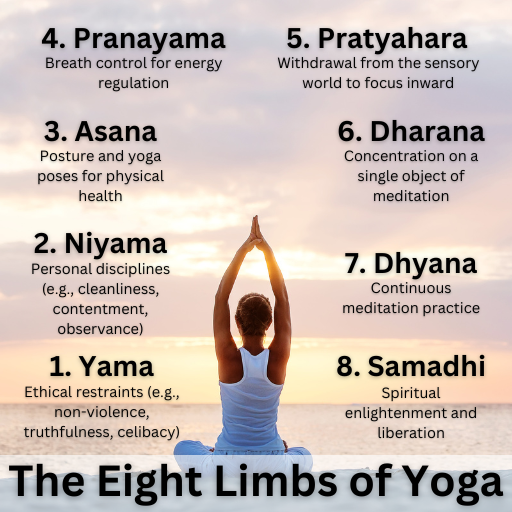
Introduction to the Eight Limbs of Yoga
The eight limbs of yoga, described in the Yoga Sutras, provide a structured path for spiritual and personal growth. Yoga is a practice that extends beyond yoga poses and asana; it is a philosophy rooted in mindfulness, ethical living, and self-discipline. Ashtanga, meaning “eight-limbed” in Sanskrit, serves as a roadmap toward self-realization and liberation from suffering.
KEY POINTS
The eight limbs of yoga, outlined in the Yoga Sutras, provide a holistic path to self-discipline, mindfulness, and spiritual growth beyond physical postures.
Ashtanga Yoga integrates the eight limbs through structured practice, combining ethical principles, breath control, meditation, and physical movement to enhance self-awareness.
Key elements like pranayama (breath control), dhyana (meditation), and samadhi (enlightenment) help deepen inner awareness and foster a connection with the true self.
Incorporating the eight limbs into daily life—through ethical living, mindful breathing, and meditation—leads to greater balance, purpose, and overall well-being.

Pop in your email below, and we’ll zip it straight to your inbox so you never lose it!
Overview of the 8 Limbs
Each limb of yoga represents a different aspect of the practice, leading practitioners from external discipline to internal awareness and, ultimately, to samadhi, the state of pure bliss and enlightenment.
The Eight Limbs of Yoga
- Yama – Ethical restraints (e.g., non-violence, truthfulness, celibacy)
- Niyama – Personal disciplines (e.g., cleanliness, contentment, observance)
- Asana – Posture and yoga poses for physical health
- Pranayama – Breath control for energy regulation
- Pratyahara – Withdrawal from the sensory world to focus inward
- Dharana – Concentration on a single object of meditation
- Dhyana – Continuous meditation practice
- Samadhi – Spiritual enlightenment and liberation
Yoga Sutras and the Eight Limbs
The Yoga Sutras, compiled by Patanjali, are the foundation of classical yoga. Yoga is restraining the mind’s fluctuations, as described in the Yoga Sutras. Key teachings such as Yoga Sutra 1.42, Yoga Sutra 1.43, and Yoga Sutra 1.44 explain how concentration deepens into abstract meditation and, ultimately, samadhi. According to the Yoga Sutras, each limb builds upon the previous one, creating a complete spiritual discipline.
Ashtanga Yoga and Its Connection to the Eight Limbs
Ashtanga Yoga, developed by K. Pattabhi Jois, emphasizes a structured yoga practice that incorporates the eight limbs of yoga. Through dynamic asana, regulated pranayama, and deep meditation, practitioners progress toward self-awareness and liberation.
Key Benefits of Ashtanga Yoga
- Enhances physical strength and flexibility
- Cultivates mindfulness and self-discipline
- Encourages a purposeful life through ethical living
How to Incorporate the Eight Limbs into Daily Life
Living by the 8 limbs of yoga means integrating ethical principles into everyday activities. Guidance on how to live according to these principles includes:
- Practicing yama and niyama through kindness and self-discipline
- Performing asana is a posture to maintain health
- Engaging in pranayama for emotional balance
- Practicing dhyana to foster a deeper connection with the true self
Meditation, Pranayama, and Inner Awareness

The practice of pranayama, sitting meditation, and focusing on the breath lead to a profound awareness of the inner world. Samadhi shines forth when all distractions are removed, allowing the yogi to transcend the external world and attain liberation.
Finding the Right Yoga Teacher
A yoga teacher plays a crucial role in guiding students through the eight limbs of yoga. Proper teacher training ensures knowledge of yoga philosophy, asana, pranayama, and meditation. For those interested, yoga teacher training programs offer structured paths to deepen practice and share knowledge.
The essence of yoga lies in self-discipline, mindfulness, and the pursuit of enlightenment. Whether through asana, meditation, or ethical living, the eight limbs of yoga provide a pathway to balance, peace, and liberation. Read on to find more insights into this profound spiritual practice and discover how it can transform your life.
If you’re interested in deepening your understanding of yoga philosophy, check out this Patanjali Yoga Sutra 1.42 – What Is Savitarka Samapatti? video by Anvita Dixit, where she explains this profound concept in the context of Yoga Teacher Training.











